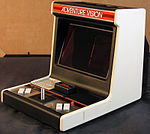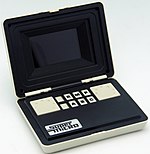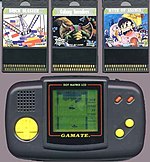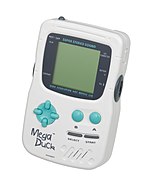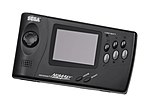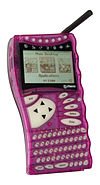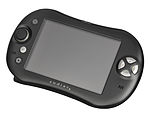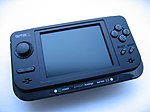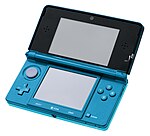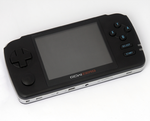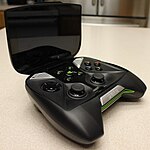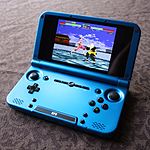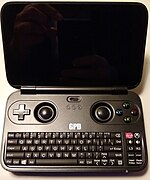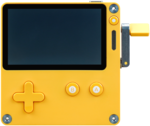Name Image Notes Release year Units Sold Ref Microvision (Milton Bradley Company )The very first handheld game console that used interchangeable cartridges.[1] Plays monochrome games from ROM cartridges .[1] Cartridges also contained the individual processor and buttons required to play game.[2] Roughly 10-12 games were released.[2] Considered a commercial failure, but a creative success that paved the way for the Game Boy 's later success.[2] 1979[2] [1] Entex Select-A-Game Dual set of input buttons above and below screen allowed for two player play on same console.[3] Plays monochrome games from ROM cartridges .[3] Only 6 games released.[3] 1981[3] [3] Entex Adventure Vision 1982[5] 50,000[5] [4] Palmtex Portable Videogame System Only 3 games released.[6] Plays cartridges containing a colored sprite overlay, using a monochrome LCD on top of the overlay to cover/uncover each sprite during gameplay[6] 1984[6] [6] Digi Casse Game cartridges contained an LCD 1984 [7] Epoch Game Pocket Computer Cartridge based handheld, with additional software built in. Monochrome display Battery life of approximately 60+ hours on 4 AA batteries. 1984 [8] Game Boy (Nintendo )1989[1] 118,690,000[12] [1] Atari Lynx First handheld electronic game with a color LCD,[3] [1] Plays ROM cartridges [13] Hardware revision smaller Atari Lynx II released in 1991.[3] Less than 100 games released.[13] Considered a commercial failure.[3] 1989[1] 500,000[14] [1] Game Gear 1990[18] 11,000,000[15] [1] TurboExpress (NEC )Internally similar to NEC 's TurboGrafx-16 home console, directly able to play its games.[3] Plays ROM cartridges [1] Technologically advanced for its time, but high price and short battery life plagued its commercial appeal.[1] [3] 1990[19] 1,500,000[14] [1] Gamate (Bit Corporation )Technologically similar to the original Game Boy .[20] Plays monochrome games from ROM cartridges on large, credit card sized cartridges.[20] Hardware revisions reported, but largely cosmetic and trivial changes.[20] At least 71 games known to have been released.[20] No exact sales figures known, but generally considered to be a commercial failure.[20] 1990[20] [20] Game Master (Hartung)1990[17] [17] Watara Supervision Technologically similar to the Game Boy .[17] Screen could be tilted relative to controls via flexible connection.[21] Hardware revision/version that looked very similar to the Game Boy .[17] Plays monochrome games from ROM cartridges .[21] Could link to a television via a link cable.[21] Considered a commercial failure, often cited due to a lack of games.[21] [17] 1992[17] [17] Mega Duck (Welback Holdings)1993[17] [17] Sega Nomad Sega 's second and last traditional handheld.Played entire Sega Genesis library and its exact ROM cartridges .[1] No games specifically made for it, no compatibility for any other Sega platforms.[3] Suffered from fast battery consumption and launching at a time when Sega trying to support many other platforms concurrently.[17] [3] Considered technical marvel but a commercial failure.[17] [1] 1995[14] 1,000,000[14] [1] Design Master Senshi Mangajukuu Bandai's touchscreen handheld game console 1995 [22] Game.com (Tiger Electronics )First handheld to feature a touchscreen and internet connection.[3] Plays monochrome games from ROM cartridges .[3] Hardware revision Game.com Pocket Pro released in 1998.[3] Considered a commercial failure.[14] [3] 1997[3] 300,000[14] [3] Neo Geo Pocket 1998[24] 2,000,000[14] [1] WonderSwan (Bandai )1999[1] 3,500,000[26] [27] [1] Cybiko Combination PDA and handheld game console.[28] Plays digital games via internet download from PC .[28] More than 430 games and applications produced, all free.[29] Hardware revision Cybiko Xtreme released in September 2001.[28] 2000[28] 500,000[30] [31] Game Boy Advance (Nintendo )2001[33] 81,500,000[34] [1] GP32 (Game Park )2001[3] 32,000[35] [1] N-Gage (Nokia )2003[37] [3] 3,000,000[14] [1] GameKing Series of low end handhelds 2003 [38] Tapwave Zodiac Combination handheld game console and PDA .[1] [3] Features a touchscreen with an included stylus and an MP3 player.[3] Plays digital games via internal memory or SD cards .[3] Received critical acclaim for its concept, but was a commercial failure, especially after Sony's 2004 release of the PlayStation Portable .[1] 2003[1] 200,000[14] [1] Nintendo DS 2004[1] 154,000,000[41] [1] PlayStation Portable (Sony )Sony 's first traditional entry into the handheld console market.[3] Plays proprietary Universal Media Discs and digital download games via internet.[42] Minor hardware revisions include PSP-2000 in 2007, PSP-3000 in 2008.[3] Major hardware revisions include UMD drive-less PSP Go in 2009, wifi-connection-less PSP E1000 in 2011.[3] Its legacy is mixed; its sales are far more than any other non-Nintendo handheld, but its sales are just over half of its main competitor of the time, the Nintendo DS .[3] 2004 80,000,000[43] [1] Gizmondo (Tiger Telematics )Plays SD cards .[44] Features camera, GPS , text messaging, and Bluetooth wireless connectivity.[45] Despite features, technologically well behind main competitors of the time of PlayStation Portable and Nintendo DS .[44] Had an alternate "Smart Ads" model released concurrently which sold at almost half the price, but required daily streaming advertisements to be watched on the handheld, well before smartphone games popularized the concept.[45] Considered a severe commercial failure, propelled by a juxtaposition low sales and particularly high promotional spending and investments.[45] [1] 2005[1] 25,000[14] [1] GP2X (GamePark Holdings )2005[46] >60,000[47] [48] Dingoo A320 (Dingo Digital Technology)2009[49] [49] GP2X Wiz (GamePark Holdings )2009[50] [50] Pandora (OpenPandora)2010[51] [51] CAANOO (GamePark Holdings )2010[45] [45] Nintendo 3DS 2011[56] 75,000,000[54] [57] [1] PlayStation Vita (Sony )Sony's second handheld console, successor to the PlayStation Portable .[58] Two models launched; a regular one, and one with 3G internet capabilities that was quickly phased out.[58] Minor hardware revisions model "PCH-2000" released in 2013 Mixed legacy; was a commercial failure, but retained a cult following, and is cited as influential in the successful PlayStation 4 home console released after it.[58] 2011[58] 16,000,000[58] [58] Neo Geo X (Tommo )Part of the Neo Geo line , releases are adaptations of past Neo Geo titles.[59] Plays games loaded on SD cards , no digital distribution .[59] Contains HDMI, A/V and control docking ports for connecting to a television.[59] The publishing and distribution was licensed to Tommo from SNK Playmore .[59] Considered a commercial failure for both parties; SNK ordered a halt on production after consumer complaints on quality, which in turn hurt Tommo financially. Both parties threatened legal action.[60] 2012[61] [60] Game Gadget Plays a number of licensed Sega games Linux based handheld 2012 ~20,000[62] GCW Zero (Game Consoles Worldwide)2013[64] [64] Nvidia Shield Portable Has a physical appearance of an Xbox 360 controller with a 5-inch screen grafted on top of it.[65] Based on Android operating system.[66] Supports HDMI connection to television or wireless game streaming from PC .[66] Launched at a high price point in a time where handheld gaming market was on the decline.[67] 2012[67] [65] GPD XD (GamePad Digital)2015 [68] Arduboy Open source hardware based on the Arduino hardware platform The original version was 1.6mm thick, with the height and width of a credit card Games published on Arduboy Arcade are free, open source and available to be edited 'Arduboy FX', an upgraded version, includes a flash memory chip that stores over 250 games on the device itself 2016 [69] GPD Win (GamePad Digital)2016[71] [71] Nintendo Switch Can be played as a handheld or on a television when put into docking station.[1] The individual Joy-Con controllers can attach to the main unit or be used separately.[72] Touchscreen display with 720p resolution, up to 1080p when docked via HDMI port.[73] Hardware revision in the handheld-only Nintendo Switch Lite in 2019, larger OLED screen model in 2021.[74] Considered a commercial success; passing 125 million sold by 2023.[75] Evercade (Blaze Entertainment)Plays officially licensed collections of emulated retro video games.[76] Design similar to original Game Boy Advance , has ability to connect to television with additional HDMI accessory.[77] Games released through curated collections of games compiled onto a game cartridge.[76] Supported by companies such as Atari , Namco , and Interplay .[76] [77] 2020[78] [76] Analogue Pocket (Analogue )Plays original game cartridge for Game Boy, Game Boy Color, Game Boy Advance, Game Gear, Neo Geo Pocket, Neo Geo Pocket Color and Atari Lynx games. Has a 3.5" 1600x1440, 615ppi Display. Designed with Analogue OS, an database based operating system Features Save States with original game cartridges. 2021 [79] Ayaneo Handheld Windows gaming PC using AMD Ryzen processors Various models include Aya Neo (2021), Ayaneo Next (2022) and Ayaneo Air/Ayaneo Air Pro (2022). 2021 [80] [81] [82] Steam Deck (Valve Corporation )A handheld console that plays most games in the Steam library.[83] Ability to run games from other game stores as well - (Epic Games Store , uPlay , etc.)[83] Comes in 3 models; one LCD and two OLED models, all with different storage capacities.[84] Has 7 inch, 800p touchscreen.[83] Ability to hook up to PC monitor or television.[83] 2022[85] ≈3,000,000 as of 2023[86] [87] [88] Thumby (TinyCircuits)Very small formfactor handheld measuring 1.2 by 0.7 by 0.3 inches (30.5 mm × 17.8 mm × 7.6 mm). Has a 0.38 by 0.27 inches (9.7 mm × 6.9 mm) black and white OLED display. Can be mounted on a keychain. Can play multiplayer games with a link cable. 2022 [89] Playdate (Panic )Has physical appearance of the original Game Boy with a crank (used as controller input) attached to right side.[90] Has a 2.7 inch black and white display.[90] New games released once per week.[91] Initial purchase of unit give user access to the first "season" of games (24 total.)[91] 2022 [90] Ayaneo 2 (Ayaneo )
2022 [92] [93] ROG Ally (Asus )2023[94] [94] 

